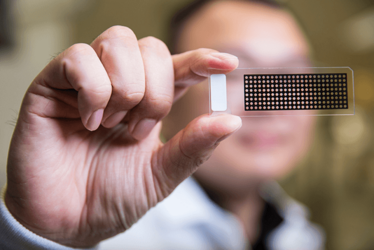Dark Fields and Diagnostic Disks
New devices for detecting tuberculosis may speed up diagnosis and improve treatment
Tuberculosis (TB) is the eighth most common cause of death in low- and middle-income countries (1) and a challenging disease on many levels. To begin with, it’s difficult to diagnose – symptoms like fever, weight loss and coughing apply to a wide range of illnesses, and many tests are inconclusive or subject to a high percentage of false positive and negative results, especially in patients with additional health problems. To reach a conclusion, doctors require a medical history, a physical examination, and a variety of tests, including skin tests, chest X-rays, sputum smears and microbiological cultures. Even after diagnosis, the battle isn’t over; treatment is long, arduous, and side effects are common – and antibiotic resistance compounds these problems. But the longer patients go undiagnosed, the worse the odds of survival become – and it is more likely that they will spread the disease to others.

Tony Hu and his colleagues from the Arizona State University’s Biodesign Institute decided to tackle the problem of diagnosis by developing a nanotechnology-based method of detecting and quantifying TB-specific proteins in circulation (2): an antibody-conjugated nanodisk that improves detection by high-throughput MALDI-TOF mass spectrometry. The disk first binds target peptides CFP-10 and ESAT-6, and then enhances the MALDI signal to allow quantification of the peptides at low concentrations. In the group’s proof-of-concept study, the disks were highly sensitive and specific, successfully diagnosing culture-positive and extrapulmonary tuberculosis even in HIV-positive patients. The specificity was similarly high in healthy and high-risk patient groups. And during treatment, the nanodisks were able to quantify serum antigen concentrations to assess how well patients were responding.
It seems the new test has everything – speed, sensitivity, specificity, and the ability to offer conclusive results from a single, low-volume blood draw. But it’s not the Hu group’s only TB diagnostic; they’ve also developed another proof-of-concept device for use in resource-limited settings (3), which takes the form of a simple dark-field microscopy system with an LED light source, a dark-field condenser, a 20x objective lens, and the user’s smartphone. It’s small, light, and cheap at under US$2,000 – but the researchers aren’t done yet, setting their sights on higher sensitivity, less weight, and a fraction of the cost.
The goal is to make high-quality TB care – and eventually, broad-range infectious disease diagnosis – available to every patient, regardless of location, health status, or resource availability.
- UC Atlas of Global Inequality, “Cause of Death” (2000). Available at: bit.ly/2j41zfR. Accessed November 17, 2017.
- C Liu et al., “Quantification of circulating Mycobacterium tuberculosis antigen peptides allows rapid diagnosis of active disease and treatment monitoring”, Proc Natl Acad Sci USA, 114, 3969–3974 (2017). PMID: 28348223.
- D Sun, TY Hu, “A low cost mobile phone dark-field microscope for nanoparticle-based quantitative studies”, Biosens Bioelectron, 99, 513–518 (2018). PMID: 28823976.

While obtaining degrees in biology from the University of Alberta and biochemistry from Penn State College of Medicine, I worked as a freelance science and medical writer. I was able to hone my skills in research, presentation and scientific writing by assembling grants and journal articles, speaking at international conferences, and consulting on topics ranging from medical education to comic book science. As much as I’ve enjoyed designing new bacteria and plausible superheroes, though, I’m more pleased than ever to be at Texere, using my writing and editing skills to create great content for a professional audience.















